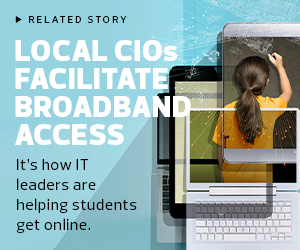As far back as 2012, broadband infrastructure was part of the master planning process for Gilbert, Ariz., a Phoenix suburb with a population of about 270,000. The fiber has provided reliable, fast connectivity for the town’s operations, including emergency services such as fire and police. Now, Gilbert officials are working to provide broadband access to residents and businesses to expand options and make the town a more attractive place to live and work.
“Throughout the years, we’ve gotten calls from businesses, and they want to see more options and more redundancy,” says Nikki McCarty, assistant to the town manager. “We’re trying to serve our residents as well, and we are working to bring more options and better service to Gilbert.”
McCarty notes that Gilbert is not an “unserved community.” In fact, according to the U.S. Census Bureau, 98.5 percent of households in Gilbert have a computer and 95.8 percent have an internet subscription. For Gilbert, the effort is a way to make sure residents and businesses always have an option that provides excellent customer service and fast speeds. The town also has several other infrastructure projects coming up, and new fiber is a way to add value. However, for many communities, municipal broadband initiatives are a response to a lack of access from existing providers.
“Municipalities around the country started to see that their communities were being left behind,” says Gary Bolton, president and CEO of the Fiber Broadband Association. “Everybody knows that broadband has moved from being an entertainment item to something that is mission-critical. I haven’t met a mayor yet who says, ‘I want to be in the broadband business,’ but every single one of them says, ‘I need jobs.’ Fiber infrastructure not only delivers jobs and economic development, but it also enables remote work, online schooling and remote healthcare — and paves the way for future services like 5G.”
It falls then to the cities to close the last mile, that remaining distance between telecommunications networks and the homes of their citizens.
Click the banner below to learn how governments are helping schools close the digital divide.


Cities Focus on Building Better Broadband
Gilbert relies heavily on its partnership with Cisco to power its broadband efforts, using Cisco routers, switches and firewalls. The town is seeking requests for proposals for the new fiber, and officials hope to start establishing fiber connections to homes and businesses by 2023. Several research organizations voted Gilbert the top U.S. city for remote workers, thanks to its embrace of hybrid offices and competitive salaries for workers based outside the office.
Wilson, N.C., has supported municipal broadband since 2008. Its Greenlight fiber-to-the-home network offers high-speed, reliable, affordable internet connectivity. The city initially pursued the effort because officials could not persuade existing providers to beef up their offerings to adequately support city services.
“One of our early realizations was that we simply did not have the network infrastructure available in the community that was sufficient for our own operations,” says Will Aycock, general manager for Greenlight. “I would have to drive around from office to office with data disks. As we were undertaking a project to install our own infrastructure, some of the major employers and institutions in the community started asking how they could get access to this fiber network.”
53%
The share of residents who said internet connection issues would cause “total disruption” in their homes
Source: alex.gilbertaz.gov, “Community Feedback: Internet Services,” Jan. 18, 2022
Greenlight uses Cisco infrastructure at its core and Fortinet and Barracuda equipment for network security. The service offers three connection speeds, ranging from 50 megabits per second to 1 gigabit per second, and has a 45 percent market share in the city.
RELATED: How does North Carolina plan to close the digital divide?
Fairlawn, Ohio, Launches Municipal Broadband to Aid Community
In the 7,500-person city of Fairlawn, Ohio, officials implored the area’s internet providers to improve their service, but to no avail.
“We were hearing from businesses that they were actually changing the shifts they were working,” says Ernie Staten, deputy director of public service for the city. “In the midday period, they couldn’t even get work done in their offices, the connections were so bad. We sat down with the incumbent telecom companies and said we would help pay for improvements, but they weren’t interested. They said our businesses and residents didn’t need that.”
Fairlawn officials took matters into their own hands, launching the FairlawnGig network in 2017 and committing $10 million to the effort over 10 years. Officials initially hoped 35 percent of residents would adopt the network, which was built with Juniper equipment. The city has far surpassed that goal, with 62 percent of Fairlawn addresses signing up for the services, despite there being three major incumbents in the city.
“In government, if you get a 35 percent take rate in any program, that’s a win,” Staten says. “We blew by that benchmark in no time.”
Click the banner below to get access to customized smart city content by becoming an Insider.


A Shifting Mindset on Broadband Access
Several states still have laws limiting the ability of municipalities to offer broadband services. In fact, Greenlight had to stop offering service to a neighboring town. Overall, however, proponents see a change in the thinking around municipal broadband. Rather than viewing it as an optional amenity, they say, many have come to see high-speed internet connectivity as an essential utility, akin to water and power.
“This is truly the new infrastructure,” Staten says. “It’s got to be placed up there with roads and bridges and everything else.”
In Gilbert, having a fiber network to support town services helped public employees pivot to remote work “at a moment’s notice,” says Eugene Mejia, the town’s deputy CTO. “Within 48 hours, we sent the majority of our workforce home. Because we’d been very thoughtful in the investments we made, we were able to pivot very quickly and adapt to remote work. There were very few issues.”
Aycock says there has been a “tremendous shift” in thought about public broadband recently. “The pandemic expedited that, with people realizing there are huge parts of public life that you can’t take part in if you don’t have broadband in your home,” he says.
DIVE DEEPER: How can state CIOs encourage broadband expansion?
Photography by Steve Craft













